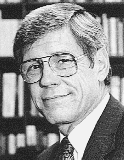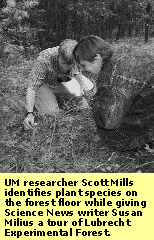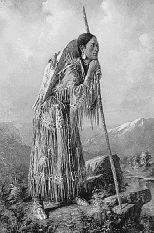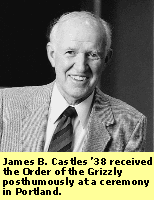
Fall 2000
CONTENTS
Start-Up Savvy
Saving Virginia
Campus Clues
AROUND THE OVAL
UM FACES
SPORTS
CLASS NOTES
ALUMNI NOTES
Contact Us
About the Montanan
PAST ISSUES
 Fall 2000 CONTENTS Start-Up Savvy Saving Virginia Campus Clues AROUND THE OVAL UM FACES SPORTS CLASS NOTES ALUMNI NOTES Contact Us About the Montanan PAST ISSUES |
Honoring Maureen & MikeThe Mansfields became a permanent fixture on the UM campus in May, with the dedication of a life-size statue. The revered statesman and the woman he credits for his success were honored in the statue sculpted by artist Terry Murphy, a Helena native. The statue took a place of honor on the mall between the University Center and the Mansfield Library. The mall has been renamed the Maureen and Mike Mansfield Mall. 
Magnus and Velma Aasheim of Mesa, Arizona, and Antelope, Montana, commissioned the work. Magnus Aasheim, a retired rancher, educator and legislator, earned UM bachelor's and master's degrees in education ('35 and '41) and Velma Clark Aasheim earned a bachelor's degree in 1936. "The University takes great pride in the Mansfields and all that they have done for Montana, the United States and the world," said UM President George Dennison at the dedication. Mike Mansfield earned a bachelor's degree from UM in 1933 and a master's degree in history in 1934. He stayed on at the University, working in administration and teaching Latin American and Far Eastern history until 1942. He has remained a history professor on permanent tenure at UM for more than five decades. First elected to the U.S. Congress in 1942, Mansfield served five terms as a representative and four terms in the U.S. Senate, where he was majority leader from 1961 to 1976. He was Ambassador to Japan from 1976 to 1988 and currently is an adviser to American and Asian leaders on issues affecting the Pacific Rim and American-Asian relations.
Native VoicesAmerican Indian voices were heard for the first time at the Missoula International Choral Festival 2000 in July. 
Organized every three or four years, the festival brings singers from around the world to Missoula for a week of performances. This year fourteen choirs from seven countries performed in various venues around town and campus. After the last festival, UM philosophy Professor Dick Walton and UM Associate Professor of music Gary Funk decided that American Indian singers should be represented as part of the American contingency. They traveled to the Fort Belknap and Fort Peck reservations and "beat the drum" for singers. The Fort Peck Oyate Singers emerged from the efforts of the professors, and this year, for the first time, American Indian voices were represented at the international event. A resounding success, the festival culminated with 800 voices joining in a finale for a packed Adams Center. The final performance featured a composition by composer and conductor Bill McGlaughlin, with lyrics drawn from Walt Whitman—"I hear America singing."
Greetings from the PresidentThe advent of the Information Age presents challenges in an order of magnitude greater for the current and coming generations. As the articles in this issue of the Montanan indicate, new technology brings with it wonderful opportunities as well as challenges. Someone reported recently the existence of six million dot-com companies in North America! I find it pleasing to learn that graduates of The University of Montana have made their presence felt among this burgeoning wave of entrepreneurs. Without a doubt, we have yet to experience the full effect of this technology. 
In terms of its impact, the revolution has just begun. The dot-coms bring us into new terrain in a business sense, but the marvels of mapping the genome and developing nanoscience make it clear that the world has indeed shifted. Medicine will change dramatically as a result of enhanced understanding of genetic functioning. Nanoscience refers to the possibilities of using quasi-genetic code to fabricate minute machines to accomplish designated tasks that we never dreamed possible. I recently met with an entrepreneur who visited campus to discuss his plans to develop vehicles for commercial travel in space, beginning with tourism and fun but getting very quickly to the more pragmatic and productive goal of "carrying people to a place for a purpose." He aims specifically at providing the spaces designed for the manufacture of products from new fabrication materials, a process possible only in "microgravity." The University will strive to remain abreast of these developments and to provide opportunities for the faculty, staff and students to compete in this rapidly changing world. To return to my opening observation, the next generation will have great opportunities to match the challenges if we in higher education prepare the way.
Biologists Forever UM became the world's epicenter for conservation biologists in June, with more than 1,300 professionals from throughout the United States and twenty-five countries gathering on campus for the fourteenth meeting of the Society for Conservation Biology. The event included about 400 papers, 60 symposium talks and 190 poster presentations on conservation-related research from around the world. Field trips were conducted for participants to habitats such as Glacier National Park, Yellowstone National Park and the Lee Metcalf National Wildlife Refuge.
New Faces on CampusUM has two new administrators this fall—a provost and a dean of the College of Arts and Sciences. Lois Muir became UM's provost and vice president for academic affairs in July, assuming the No. 2 administrative position at UM and becoming the highest-ranking woman in the University's history. Muir replaced Robert L. Kindrick, who left UM for a similar position at Wichita State University in Kansas.
Muir's mother grew up and taught school in Montana. "I was raised with her stories of childhood in Montana," Muir said. "As an adult, she taught school in a one-room schoolhouse that still is in use in eastern Montana. She longed to return to Montana but was never able to do so. In a sense, I am returning in her place to the home she loved." Muir was associate provost and professor of educational psychology at Ohio's Kent State University from 1996 until taking the UM position. Before that she held several positions at Kent State and served on the faculty at Kennesaw State University in Georgia, Indiana University, Rutgers University and the University of Wisconsin in La Crosse. Thomas A. Storch replaces College of Arts and Sciences Dean James Flightner, who retired after serving more than a decade as dean. Storch comes from Marshall University in Huntington, West Virginia, where he was dean of the College of Science since 1994. He brings to UM more than thirty years of academic experience, including research, teaching, public service, fund raising and administrative leadership. Over the years he has taught sixteen courses, ranging from zoology and limnology to algology, aquatic microbiology and watershed processes. He's been credited with pulling in more than $3.18 million in research and education grants during the past decade. The Great Montana Dog & Pony ShowNot many people know that the University owns original works by Picasso and Rembrandt or that UM lists more than 9,500 works of art in its permanent collection, a public trust established in 1894. The collection is owned by the people of the state and is considered one of Montana's cultural treasures. 
A limited number of works from the permanent collection have been exhibited in two small galleries in the Performing Arts/Radio Television Building, but it has no permanent public home. UM's Museum of Fine Arts is trying to change that. Its main mission this fall is to raise money and public support for development and conservation of the collection; long-term plans call for creation of a new museum space on campus where the permanent collection may be viewed, studied and enjoyed year-round. Enter the Great Montana Dog and Pony Show—an elegant extravaganza to be held November 4 in the newly remodeled UC Ballroom. Featured will be a live auction of thirty artworks, fifteen of which are life-size three-dimensional animals—dogs, horses, ponies and a grizzly bear transformed by individual artists. Another key event will be the unveiling of a limited edition reproduction of Edgar Paxson's famous portrait, "Sacajawea," and the auctioning of the first print of that edition. Call (406) 243-2019 to learn more about the show or to make reservations. Last CallWe've been badgering our alumni readers for a few issues now, asking for 500-word articles on favorite UM professors and, more recently, for photos of personalized Griz license plates. The good news is we've received plenty of articles on favorite professors (but we'll take more). Maybe you've guessed the bad news: We need more photos of personalized plates! This is the last call. Please send articles and photos to the Montanan, 315 Brantly Hall, The University of Montana, Missoula, MT 59812. UM Gets National Lewis and Clark Education CenterMeriwether Lewis traveled through the Missoula Valley in the summer of 1806. Nearly two hundred years later the valley's premier educational institution became the center of Lewis and Clark learning for the nation. In May, UM's Earth Observing System Education Project was chosen by the National Lewis and Clark Bicentennial Council to house a new National Lewis and Clark Education Center. The center will draw from Lewis and Clark experts throughout the country and will be a leading provider of information about the 2003-2006 celebration of the Corps of Discovery's cross-country trek. A main mission of the center is to train teachers to use satellite imagery, multimedia production, Internet delivery and geospatial data to augment their instruction about the famed explorers and their expedition. A Boost for Entrepreneurs
A program established in April at UM is designed to give a boost to Montana Internet entrepreneurs. The Northern Rockies Research Park and Technology Corridor (NorCor) will soon provide assistance to technology-related start-up firms throughout western Montana. Created through a grant from the U.S. Department of Housing and Urban Development, NorCor will provide facilities, venture capital, communications systems and mentoring programs through UM's business school, the Montana World Trade Center, Montana Business Connections and private individuals. In Missoula, a nonprofit corporation already has been formed to manage the Montana Technology Enterprise Center, to be located across the Clark Fork River from UM's main campus. Similar NorCor operations also will be coordinated through Ravalli, Lake and Flathead counties.
Death on the OvalFor anyone familiar with UM's campus, it is shocking to approach the Oval and find a large "hole" where trees once stood. The stately Dutch elms, most as old as the campus itself, have slowly succumbed to the deadly Dutch elm disease, and removal of stricken trees has been on going for many years.
Lukas and others, including members of the campus Arboretum Committee, have worked out a plan for replacing the elms. The four-phase plan calls for planting forty Sugar Maples to form the inner tree ring on the Oval and clusters of Red and Bur Oaks on the outer ring. A private donation by an individual provided for the planting of three mature trees in front of the Davidson Honors College last year. At this point, replacement of trees is "nonbudgeted." The committee hopes donors will step forward to help with funding. Lukas was given a directive from President Dennison to replace the trees with as mature a tree as is available. He expects the project to take six to ten years, depending on the financial support received. Anyone interested in contributing to the project may contact Sharen Peters at the UM Foundation Development Office, (406) 243-2593. When Education Becomes a Family ChoiceThere are graduation stories and there are graduation stories. Mike McKay talked a lot with his children about the importance of education, and when they started to struggle in college, he and his wife, Debbie, decided the best way to help would be to lead them through college themselves. Last spring they donned caps and gowns with their daughter, Kim, and walked to the stage to live a dream: all were earning undergraduate psychology degrees. The McKays' educational odyssey began six years ago. Born and raised on the Blackfeet Indian Reservation, Mike had a job as a housekeeping supervisor at the Browning hospital and Debbie was a home health-care attendant. They had three children of their own and also were committed foster parents, raising seventeen foster children in Browning over a twenty-seven-year period. But both had always wanted to attend college, and when their son, John, dropped out of UM and Kim was considering it, they decided it was time for the whole family to be educated. Mike, Debbie, Kim and John all enrolled at UM in 1994. Finding affordable housing in Missoula for their large brood—children, grandchildren and three foster children—and surviving on student incomes were definite challenges. McKay supplemented their income by commuting to Browning to work forty-hour weekends in a home for abused children. Debbie and Mike McKay chose psychology as a major—something they had practiced informally as foster parents. Soon their children also gravitated toward the major, and the family found themselves attending many of the same classes together. Mike intends to return to UM in the fall to start work on a master's degree. John will graduate next year. Debbie and Kim say they are content with their undergraduate degrees. They plan to stay in Missoula and put their psychology training to good use by opening a long-term center for Indian teenagers.
AROUND THE OVAL• SPORTS • CLASS NOTES • ALUMNI NOTES FEEDBACK•STAFF • ABOUT THE MONTANAN •ARCHIVES HOME • CONTENTS
|